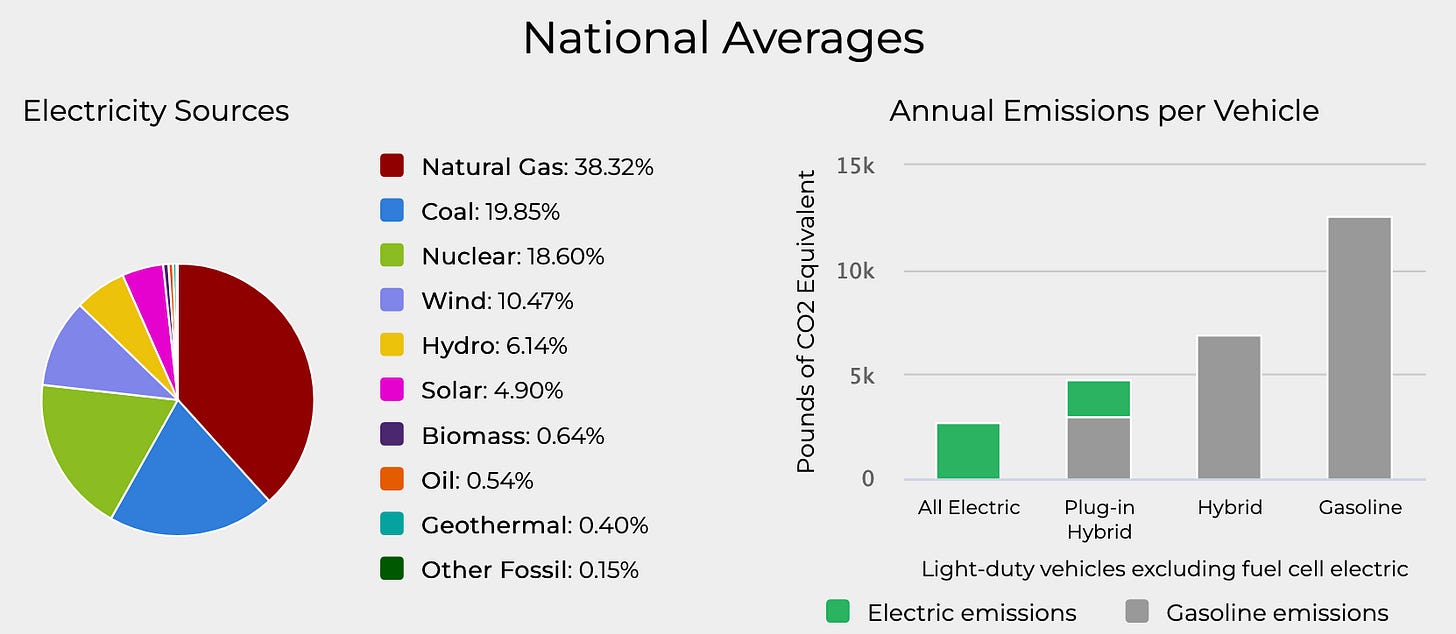Yes, Electrification Slashes Emissions
That doesn't mean it should be our only focus, but it's still crucial.
I started this Earth Month by writing a joke post about a new way to generate 100% clean energy. But this week, I’m addressing a serious question: Will we really cut emissions by electrifying everything?
Spoiler: You can see the answer in the title of today’s newsletter.
Why electrify?
I’ll get into that a bit more, but first, let me answer another question: Why do we need to electrify everything? Because to fight climate change, we need to break up with fossil fuels. That means 1) switching to clean energy sources and 2) ensuring that our buildings and transportation are powered by the electricity generated from those clean energy sources.
Will this fix all our problems? No, it will not. Let me be clear about this. Although I agree with
that clean electrification is the non-negotiable climate action “entrée” and everything else is a side dish, people often forget how important side dishes are — not to mention our whole approach to our diet. When it comes to climate action, we need a full menu of balanced meals. That means rethinking our whole climate diet. It means reducing our consumption (of energy and everything else), sourcing stuff (energy, food, and everything else we can) as locally as possible, and changing our urban land use. And if we really want to thrive, it means transitioning to a system that serves us better than our current form of capitalism.All of that is true. And it’s also true that people will still want to drive cars, cook, and heat their homes and showers.
Can we do that while cutting emissions? Yes, we can. We already are.
Cars
The used Bolt EV that Rafael and I drive is powered by our solar panels, so it’s a pretty low-emissions car.
If we didn’t have solar on our roof, though, our car would still be on the clean side, because of California’s energy mix of about 50% clean sources (more if you include nuclear):

And in fact, a recent study at UC Berkeley found that CO2 emissions dropped by 1.8% annually in the Bay Area between 2018 and 2022, correlated with increased EV adoption in the region.
Your state may use a smaller percentage of clean energy sources than California, but nationwide, EVs still produce far less emissions than gas-powered cars:
Even in a coal-heavy state like Kentucky, which has almost no renewables, EVs come out ahead:
You can see the situation in your state using this handy DOE tool, where I got these charts. The tool uses 2022 data; with our nation’s energy sources getting cleaner all the time, emissions from EVs will only keep improving.
“But what about a car’s life cycle?” I hear you ask. Good question. It turns out that even there, EVs come out ahead:
Again, this doesn’t mean that switching to EVs (which includes buses and trucks) will solve all our problems. EVs are not magic bullets, and our car-centric culture creates problems that extend beyond emissions and the use of natural resources. It’s important to be clear about both the pros and the cons of EVs; for more on that, see this excellent piece by
of .Furnaces and water heaters
We can also cut the greenhouse gas emissions produced in our homes — about 20% of all U.S. emissions — by switching to electric heat pump heaters (which double as air conditioners) and heat pump water heaters.
Continuing on my theme of being realistic: Heat pumps aren’t cheap, though new incentives are making them more affordable. Many contractors aren’t yet familiar with them, and it’s hard to sort through all the information.
But one thing is clear: as with EVs, even if the electric grid in your state is mostly powered by fossil fuels, running a heat pump produces far lower emissions than your traditional furnace or water heater.
In a recent study, the National Renewable Energy Laboratory found that heat pumps slash emissions across the U.S., even in fossil-fuel-reliant states.
I couldn’t find cool charts like the ones for EVs, but this map from the Rocky Mountain Institute shows emissions reductions from heat pumps for different states at a glance:

Because heat pumps are much more efficient than their fossil-fuel-powered counterparts, they will also probably lower your power costs — especially if they’re powered by solar energy.
Stoves
You may think your gas stove isn’t much of a pollution emitter, but it turns out that it’s leaking methane into your home. Methane is a potent greenhouse gas, but the good news is that it takes only a decade for methane emissions to dissipate, compared to hundreds or thousands of years for CO2 — making reducing methane emissions the quickest way to fight climate change.
Researchers at Stanford have found that there’s more methane than you might think leaking from gas stoves inside U.S. homes — it’s comparable to the CO2 emissions from about 500,000 gas-powered cars.
Plus, gas stoves make your home less healthy, as depicted in this “reality show” trailer from Hot & Toxic:
You may not be ready to make the switch, but when you are, check out my post about induction stoves for more information.
Beyond cars and appliances
If electrification and clean energy are the climate action entrées, what are the side dishes?
The climate action menu is varied and versatile! It includes food-related actions anyone can take, like eating less meat and reducing food waste. Taking public transit, walking and biking, and recycling and composting also make the list.
Mostly, we need to pressure corporations and elected officials to change our systems. We need more walkable and bikeable cities, better public transit, and limits on urban sprawl. Check out my friend
’s newsletter, , for actionable tips on how to make your community safer, more accessible, and greener.We also need to challenge our system of prioritizing profits and growth at all costs. That’s a bigger, more daunting task than making our cities more livable, but it’s a necessary one if we want to make our planet more livable.
It has to be done one step at a time, and no one person can do it all. If you want to take on urban improvement activism, that’s great. If you’re up for reducing food waste and cutting down your meat consumption, you’ll already be doing a lot.
And if and when you’re able to electrify your home, now you don’t need to question whether you’ll be reducing your greenhouse gas emissions. The data are clear — and if enough of us do it, our air will be, too.
Previous posts on how you can electrify and switch to clean energy:








Thanks for the great walk through and the shout out!